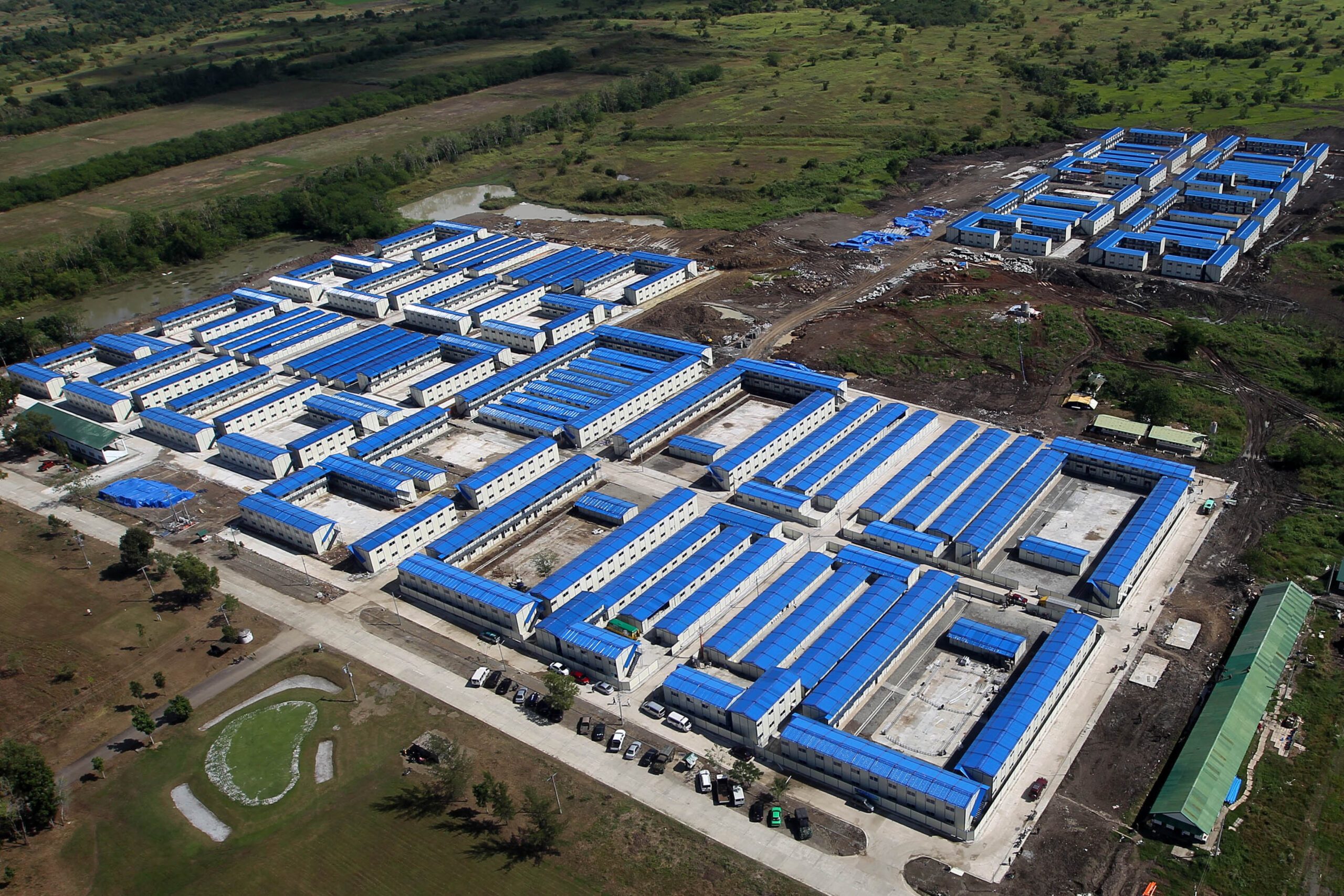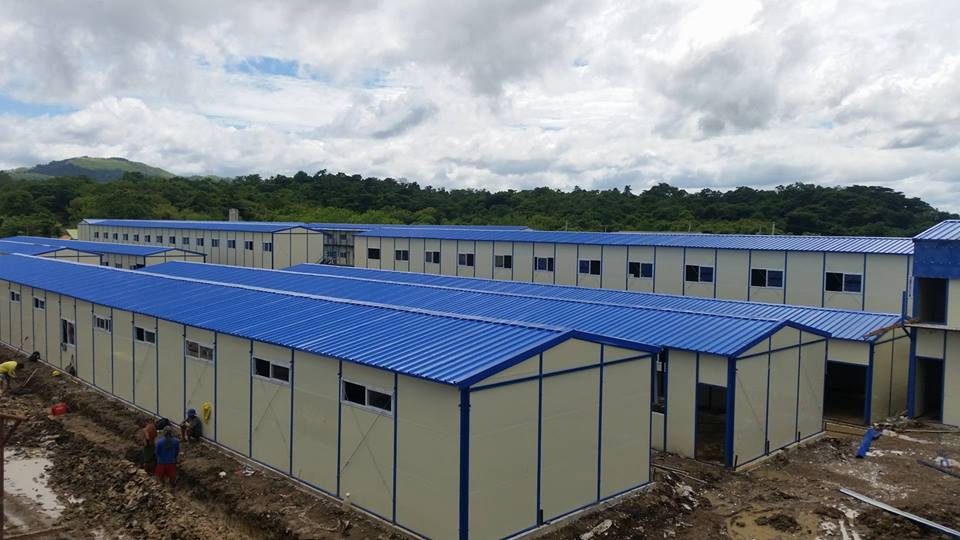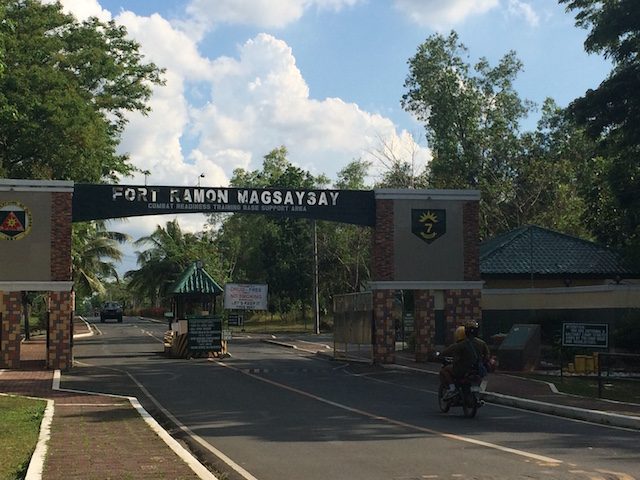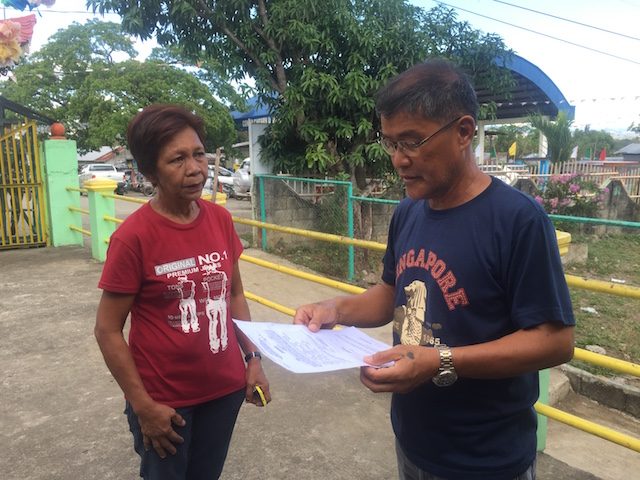SUMMARY
This is AI generated summarization, which may have errors. For context, always refer to the full article.

MANILA, Philippines – The 10,000-bed mega treatment and rehabilitation center (TRC) in Fort Magsaysay, Nueva Ecija may be the last of its kind for now, a high-ranking official of the Department of the Interior and Local Government (DILG) indicated.
“I don’t suppose that we will be continuing with the concept of mega rehab,” DILG Undersecretary for Operations John Castriciones told Rappler in an interview.
Admission woes hound the 161-building mega facility over 4 months since it was inaugurated by President Rodrigo Duterte himself.
As early as August 2016, the health department revealed its plans to build “very big” TRCs with 2,000-bed capacities.
Health Secretary Paulyn Ubial even went to China in September 2016 to sign a memorandum of understanding for the mega TRC in Nueva Ecija. This paved the way for the construction of the P1.5-billion facility donated by Chinese tycoon Huang Rulun.
But in January 2017, Ubial revealed that the 3 other proposed mega TRCs to be built in Luzon, Visayas, and Mindanao will accommodate just up to 500 patients – not as huge as the 11-hectare compound in Nueva Ecija.
Health Spokesperson Eric Tayag said they realized as early as 2016 that building very big facilities like the mega TRC is not the way to go.
Downgraded estimates
At first, the idea of building mega TRCs came about because they had to prepare for the residential rehabilitation of 1% to 10% of drug surrenderers in the country.
If the country now has over 1.25 million drug surrenderers, it is estimated that at most, around 125,000 of them will need residential services in TRCs.
“Hindi kami puwedeng mag-prepare sa mababang range, so 10% daw ang puwedeng mangailangan ng treatment rehab center…. ‘Yung capacity namin 5,000 lang ‘pag pinagsama mo na lahat ng treatment rehab centers sa ating bansa, kaya naisipang maglagay ng 4 na mega [TRCs],” he said in an ambush interview on Friday, April 7.
(We can’t prepare for a low range, so they say 10% will need to be admitted to a treatment rehabilitation center…. When you combine all our treatment and rehabilitation centers in the country, our capacity is just 5,000, so we thought of building 4 mega TRCs.)
He added: “Kaso as the days passed, lumalabas doon sa assessment na ang mas marami, na community rehab lang pala. Hindi naman kailangan ng treatment rehab center. Kaya nagda-downgrade ‘yung mga estimates.”
(But as the days passed, our assessment showed that most of the drug surrenderers only needed community rehabilitation. They don’t need to be admitted to a treatment rehabilitation center. That’s why we downgraded our estimates.)
Ubial believes most of the drug surrenderers at present are only “mildly affected” by drugs. The “hardened users,” she suspects, are still at large.
“Maybe the hardened users are those who are still at large and still not in rehabilitation centers, so that’s why we still continue [to accept donations], and [why we] need the help of the police, because they are the ones who are probably resistant to rehabilitation and therefore would really need security and law enforcement to get to them,” Ubial said in a mix of English and Filipino after an April 3 press conference.
Admission woes
During that ambush interview, Ubial revealed they have now put the capacity of the Nueva Ecija TRC at just 500 patients. The first phase of the mega TRC was initially pegged at 2,500.
“500, sapagkat ‘yung kwenta namin, ito ‘yung bilang ng maaaring maproseso sa takdang panahon para sila ay mailipat doon,” Tayag said. (500, because based on our estimates, this is the number of drug surrenderers that we can process at the right time to be transferred there.)
He added: “Tandaan niyo po, ‘yun ay Nueva Ecija, so kung ang surrenderer sa Mindanao, hindi naman praktikal na siya ay dalhin sa Nueva Ecija, kaya madadala doon, malilimitahan doon sa malapit sa lugar, sapagkat kailangan natin na ‘yung pamilya nila ay bibisita rin sa kanila sa takdang panahon, depende sa programa po ng drug dependent na ‘yun.”
(Remember, this is in Nueva Ecija, so if the surrenderer is in Mindanao, it’s not practical to bring them to Nueva Ecija, so they will be brought to a center near them, because we need the family to be able to visit them at the right time, depending on the program of the drug dependent.)
To date, the health secretary said that only around 179 patients have been admitted to the mega TRC.
Castriciones said government is trying to “adjust based on need” since this is the first time the country is experiencing a huge number of drug surrenderers.
“There’s no other experience from which we can borrow or adopt best practices, so we are trying to adjust based on the need, and what we noticed is that if we are going to concentrate big rehabilitation centers in one region, there would be some difficulties,” he added.
For instance, he said the number of patients from one region alone is not enough to fill a big regional rehabilitation center. Patients from other regions, meanwhile, have “apprehensions.”
“Because most or majority of these so-called drug surrenderers are breadwinners, so what would happen to their families if they would leave their families [and go to the mega TRC]?” he asked.
Castriciones said drug surrenderers are also worried about the stigma that comes with drug rehabilitation, and what happens after admission. (READ: Inside the brain of a drug user)
“‘What now after I get out? Meaning, will I be able to cope with the demands of society?’ Because in the first place, the very reason why these people are there is because of poverty,” he added.
DILG heads the inter-agency task force for the establishment and support of drug abuse TRCs throughout the country, by virtue of Executive Order 4 signed by the President in October 2016.

‘You cannot force patients’
If only 179 patients have so far been admitted to the mega TRC, where are the rest of the drug surrenderers needing residential services?
“More often than not, they would prefer [to go to the nearest TRC] where they are located,” he explained.
“You cannot force the patients – they are not prisoners in the first place. You cannot just order them around. It has to be voluntary.”
Patients from overcrowded TRCs such as the one in Bicutan can also go to the mega TRC “if they’re willing,” since the new drug rehabilitation center in Taguig City won’t be completed until 2018.
Since the campaign against illegal drugs started in July 2016, government has been trying to “fast-track” the process of admitting surrenderers to the government’s drug rehabilitation program.
In January, Ubial said the health department had made arrangements with the DDB and the Philippine Drug Enforcement Agency so that drug surrenderers can be admitted even without a court order, as long as they have been assessed by a trained health care provider.
Castriciones said they’re also deputizing DDB representatives who can issue a temporary confinement order for 30 days, until the issuance of a permanent court order from special courts.
“When a surrenderer wants to go to a drug rehabilitation center, he must obtain a permanent court order from the court, and our problem is not all courts can issue the permanent court order. There are only those what we call special courts that handle drug cases, and it would take a very long time before the court order is to be issued, so those are the stumbling blocks,” he explained.
Right now, Ubial said there are already 12,000 patients in about 44 rehabilitation centers nationwide.
‘Ready’ for next wave of surrenderers
Tayag dismissed criticisms that the mega TRC is “nilalangaw” (not well-attended), saying that it’s precisely because of the admission process that it’s taking government long to fill up the facility.
Asked if it’s considered a waste to build such a big facility, Tayag said no.
“Hindi. It’s worth it, saving one life, lalo na alam natin na ‘pag nag-shabu ka halos wala nang pag-asa ‘yun. We’re still making efforts kasi rehabilitation can reverse it if done on time and properly,” he said.
(No. It’s worth it, saving one life, especially because we know that if a person takes shabu, it’s almost a hopeless case. We’re still making efforts because rehabilitation can reverse it if done on time and properly.)
Asked if it’s still realistic to expect the 10,000-bed capacity of the mega TRC to be filled, he replied, “Hindi ‘to sa pagpupuno ng treatment rehab center. Ito, it’s about changing the lives of those who have surrendered and making sure they’re given rehabilitation services regardless kung punong-puno ‘yung facility namin, or kakahug-kahog.”
(It’s not about filling up the treatment rehab center. It’s about changing the lives of those who have surrendrered and making sure they’re given rehabilitation services, regardless if the facility is filled to the brim, or if it’s scrambling.)
Tayag insisted that the mega TRC has to be ready just in case the “next wave” of drug surrenderers would need residential services.
“Kasi sa ngayon, community rehab [ang kailangan]. Baka mamaya, ‘yung mga susunod na wave ng surrenderers e talamak pala ‘yung paggamit nila, so mapupunta sila ‘dun [sa Nueva Ecija] kung voluntarily pipiliin nila,” Tayag explained.
(Right now, most drug surrenderers need community rehabilitation. But it’s possible that eventually, the next wave of surrenderers will need residential services, so they can go to Nueva Ecija if they choose it voluntarily.)
“Expandable ‘yun, sapagkat ‘yun ay nai-plano sa 10,000, so kung magiging 10,000 ang kakailanganin, madaling-madaling magagawan ng paraan ‘yun.”
(That’s expandable, because we’ve planned it for 10,000, so if we ever need a 10,000-bed facility, we can easily arrange that.)
The Dangerous Drugs Board’s (DDB) latest survey on the drug use situation in the Philippines shows there are 1.8 million current drug users in the Philippines, but Duterte has repeatedly said in his speeches that there are 3 to 4 million drug addicts instead.

Mega TRC for community rehab?
Since only 179 patients have been admitted to the mega TRC to date, it’s not surprising that the facility “is not being fully utilized” yet.
For now, Castriciones said they’re looking at opening their buildings to nearby Nueva Ecija barangays (villages) that want to conduct their community-based drug rehabilitation programs in the Fort Magsaysay facility.
“Right now, we are…trying to utilize the community-based [drug rehabilitation] to be introduced there in Fort Magsaysay,” he explained.
Castriciones said they will tap the services of the Church, and priests can bring in drug surrenderers to Fort Magsaysay.
“Since they are not in-patients and there’s no need for them to utilize furnishings such as bunks, like beddings, like water, etcetera, they can only use the buildings for purposes of community-based [drug rehabilitation],” he explained.
This could be helpful for barangays like Barangay Barrio Militar in Palayan, Nueva Ecija, which had to make do with limited resources for their community-based drug rehabilitation.
At least 19 of the 50 drug surrenderers in the barangay attended Bahay Pagbabago for a 24-day community-based drug rehabilitation program that ran from November to December 2016.
The seminars facilitated by the police, the DILG, and religious groups were held in a small barangay library located near the barangay hall.
Jerry Caccam, one of the barangay councilors, said they continue monitoring the drug surrenderers who have already attended Bahay Pagbabago.

But he pointed out that their next batch of surrenderers might have to attend Palayan City’s community-based drug rehabilitation program instead, “para minsanan na lang” (to cater to everyone in the city all at once).
As head of the Barangay Peace and Order Committee, Caccam often joined the police as they went from door to door, knocking and pleading for drug users and pushers to turn over a new leaf.
This operation, popularly known as Oplan TokHang, has become the norm even in a barangay located near Fort Magsaysay.
“Marami pala talaga dito sa barangay namin (It turns out there are many drug users and pushers here in our village),” Caccam told Rappler in an interview.
He added, “Mayroon kaming alam noon na paisa-isa lang…pero noong ganun na nga, noong may nahuli na, [tinactical interrogation] namin, kumanta sila, [at] ang dami pala.”
(We knew a few of them before, but when we already arrested some, and they went through tactical interrogation, they spoke up, and we learned there are many of them after all.)
To date, only one drug surrenderer from the barangay has been admitted to the mega TRC inside Fort Magsaysay.
‘Little by little’
Despite the challenges faced by the mega TRC in its first 4 months, Castriciones still believes the facility is sustainable.
But he said it has to be done “little by little” since the mega TRC “demands a lot of resources”.
“It normally takes time. That’s the reason why a lot of people are complaining, criticizing, ‘How come you have not filled the mega rehab center yet?'”
He said those critical of the mega TRC “don’t really understand the situation.”
“You know, when this was given to us, it was given for free, it was a donation. We cannot demand from them, so they did not take care of the so-called operational cost. We have to take care of it, but we don’t have any budget to meet those challenges,” he said, referring to the 2016 budget.
Fortunately, the 2017 budget already has a P2.6-billion allocation for government-owned TRCs.
“You know how it is [when] you have a donor and there is a donee. You can’t normally [say], ‘I want something like this.’ No. They’re the ones who offer, and more often than not, we’ll just receive it. And since there really was a demand for [the mega TRC] during that time, we had to do it,” Castriciones added.
He explained that a 500-bed drug rehabilitation center alone would require P700 million. Asked how much it will cost the government to operate the mega TRC once it’s complete, Castriciones admitted he does not yet know the estimate.
“But it would be very expensive. What about the food? What about the utilities?”
They are also getting donations from “concerned citizens” and “people who are well-off.” The donation varies, from hundreds of chairs and tables, a bus from Cesar Hernandez of the 5-Star Transit and Victory Liner, to at least two transformers for electricity connection.
“A lot of people are donating because they know we don’t have the resources. That is the truth,” Castriciones admitted.
The last time he visited the facility, there were already beds in at least two floors, while the comfort rooms have to be improved “because it’s a Chinese technology, iba naman tayong Pilipino (it’s different for us Filipinos).”
“We are [also] looking for a source of water, because you know there’s a very scarce supply of water in Fort Magsaysay, so we’re tapping places where we can get water for the continuous supply,” he explained.
“Right now there’s only a limited number of people there, so the water is still okay. It’s temporary, but later on, when it reaches to 10,000, can you imagine how much water is needed? And also the electricity,” he added.
In October 2016, Ubial said the vision behind building these facilities inside military camps is for the health department to turn them over to the military once government has reduced the number of admitted drug dependents in the country.
Given the drug situation, when exactly that will happen is anyone’s guess. – Rappler.com
Add a comment
How does this make you feel?
There are no comments yet. Add your comment to start the conversation.